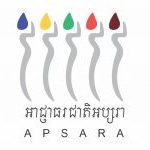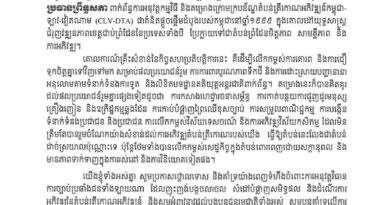ខឿនកំពង់ទឹកដែលស្ថិតនៅខាងកើតប្រាសាទព្រះខ័ន គឺជារចនាសម្ព័ន្ធមួយក្នុងចំណោមរចនាសម្ព័ន្ធផ្សេងៗនៃប្រាសាទនេះ កសាងឡើងក្នុងរាជ្យព្រះបាទជ័យវរ្ម័នទី៧ ចន្លោះចុងសតវត្សទី១២ដល់សតវត្សទី១៣ ជាព្រះពន្លាជ័យ ឬកន្លែងសម្រាប់ព្រះរាជា ធ្វើដំណើរតាមទូកទៅកាន់ក្រុមប្រាសាទនាគព័ន្ធនៅលើកូនកោះកណ្តាលបារាយជ័យតដាក។ លក្ខណៈសំណង់បែបនេះឃើញមាននៅស្រះស្រង់ នៅលើខ្នងទំនប់ខាងលិចនៃបារាយណ៍យសោធដាក សព្វថ្ងៃហៅ បារាយខាងកើត និងនៅខាងកើតប្រាសាទបន្ទាយឆ្មា។
ដោយពិនិត្យឃើញរចនាសម្ព័ន្ធរបស់កំពង់ទឹករងសភាពខូចខាតទ្រុឌទ្រោមខ្លាំង ទើបឆ្នាំ២០២២នេះ អាជ្ញាធរជាតិអប្សរា ចាប់ផ្តើមសិក្សាអំពីគម្រោងជួសជុលពង្រឹងរចនាសម្ព័ន្ធកំពង់ទឹក ដែលនៅសល់ឡើងវិញ ដើម្បីថែរក្សានូវរូបរាងសំណង់ឲ្យបានគង់វង់។
លោកជា សារិទ្ធិ បុរាណវិទូ និងជាប្រធានគម្រោងជួសជុលកំពង់ទឹក នៃអាជ្ញាធរជាតិអប្សរា មានប្រសាសន៍ថា គម្រោងនេះចែកជាពីរដំណាក់កាល ហើយដំណាក់កាលទី១ ចាប់ផ្តើមនៅខែមករា ឆ្នាំ២០២២ រហូតដល់បច្ចប្បន្នបានបញ្ចប់ការងារជួសជុលរួចរាល់។ លោកបន្តថាមូលហេតុ ដែលនាំឱ្យមានការជួសជុល ដោយសារខឿនកំពង់ទឹកមានការខូចខាត និងបាត់ថ្មអស់ច្រើន ដោយកត្តាអាយុកាលនៃសំណង់ ឬសឈើចាក់បំប៉ើងថ្ម ទឹកភ្លៀងហូរច្រោះដី នាំឱ្យខឿនជុំវិញស្រុតចុះ និងផ្នែកខ្លះរអិលធ្លាក់ចូលក្នុងទឹកជាដើម។ មុនពេលដំណើរការជួសជុល ក្រុមការងារបានធ្វើកំណាយស្រាវជ្រាវ ហើយរកឃើញថ្មមួយចំនួនត្រឡប់មកវិញ និងបានយកថ្មទាំងនោះរៀបចំទៅក្នុងទីតាំងដើមវិញ។
លោកបានបន្តថា ក្រោយពេលជួសជុលកំពង់ទឹកនេះ នឹងមានភាពល្អប្រសើរ ហើយរឹងមាំ ដែលរក្សាបាននូវតម្លៃដើមនៃសំណង់បុរាណ ធ្វើឱ្យភ្ញៀវទេសចរអាចស្គាល់ថា ព្រះពន្លាជ័យ (កំពង់ទឹក) ។ ជាពិសេសផ្តល់ភាពងាយស្រួលដល់ភ្ញៀវទេសចរអាចធ្វើដំណើរឆ្លងកាត់ទៅទស្សនាប្រាសាទព្រះខ័នផ្នែកខាងកើត និងអាចទស្សនាទិដ្ឋភាពប្រាសាទនាគព័ន្ធលើកោះកណ្តាលបារាយជ័យតដាកសព្វថ្ងៃហៅថាឬបារាយខាងជើង។
សូមជម្រាបថា សំណង់កំពង់ទឹកខាងកើត ប្រាសាទព្រះខ័ន សាងសង់នៅលើខ្នងទំនប់ខាងលិច នៃបារាយខាងជើង រចនាសម្ពន្ធនៃកំពង់ទឹកនេះផ្នែកខាងកើតរាងកាកបាទមានជណ្តើរបីទិស ផ្នែកកណ្តាលមានខឿនធំបណ្តោយពីខាងលិចខាងកើតប្រវែង២០ម៉ែត្រ ទទឹងខាងជើងខាងត្បូងប្រវែង២០ម៉ែត្រ។ ទីតាំងនេះ ធ្លាប់មានការធ្វើកំណាយសម្អាត ក្នុងសម័យបារាំងនាឆ្នាំ១៩២៨ បន្ទាប់មកក្នុងឆ្នាំ២០០៦ អង្គការមូលនិធិប្រាសាទពិភពលោក បានសិក្សាស្រាវជ្រាវធ្វើកំណាយសម្អាតជុំវិញខឿន ដើម្បីសិក្សាប្លង់ស្ថាបត្យកម្មនៃកំពង់ទឹក និងឆ្នាំ២០២២នេះ អាជ្ញាធរជាតិអប្សរា បានធ្វើការងារជួសជុលពង្រឹងឡើងវិញ៕
អត្ថបទ៖នាយកដ្ឋានស្រាវជ្រាវ បណ្តុះបណ្តាល និងផ្សព្វផ្សាយ
រូបភាព៖នាយកដ្ឋានអភិក្សប្រាសាទ និងបុរាណវិទ្យា
The terrace platform, located east of Preah Khan temple, is one of the structures of this temple built during the reign of Jayavarman VII between the late 12th and the early 13th century as a pavilion or place for the king to travel by boat to the Neak Poan temple on the central island of Northern baray. This type of construction can be seen in Sras Srang, Eastern barray, and Banteay Chhmar temple.
The structure of this terrace was severely damaged, so in 2022, the APSARA National Authority started studying the project to restore and strengthen this terrace structure.
Chea Sarith, an archaeologist and head of this terrace restoration project, said that the project was divided into two phases, with the first phase starting in January 2022 and now being completed. He added that this terrace was damaged and lost a lot of stones due to the age of the construction, the tree roots, and soil erosion, which led the terrace structure to collapse into the water and so on. Before the restoration process, the team excavated and found some stones and put them back in their original place.
Mr. Sarith confirmed that after the renovation, this terrace will be better and stronger, which retains the original value of the ancient construction, making it possible for tourists to know that the terrace (pavilion). In particular, it is convenient for tourists to visit the Preah Khan temple on the east side and to see the view of Neak Poan temple on the central island in the northern baray.
It should be noted that the eastern terrace of Preah Khan temple was built on the western embankment of the northern baray and it was 20 meters by 20 meters. The site was excavated during the French period in 1928. In 2006, the WMF studied and excavated this terrace flatform to study its architectural structure, and in 2022, the APSARA National Authority started the restoration project of this terrace.
Article: Department of Research, Training, and Communication
Photos: Department of Conservation of Monuments and Preventive Archaeology





